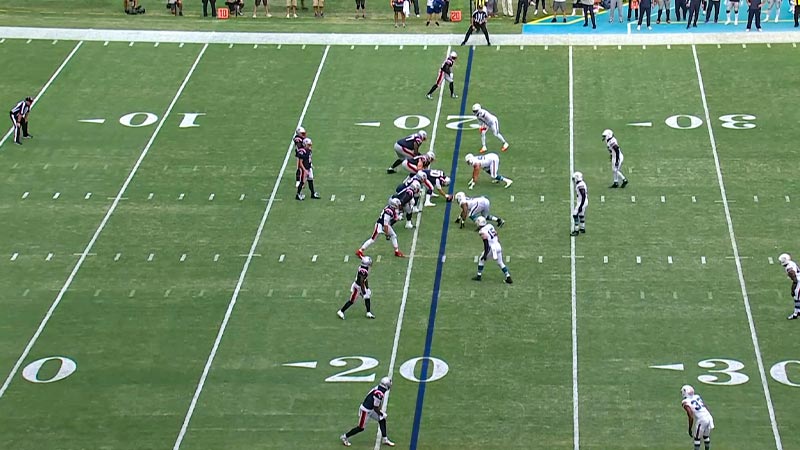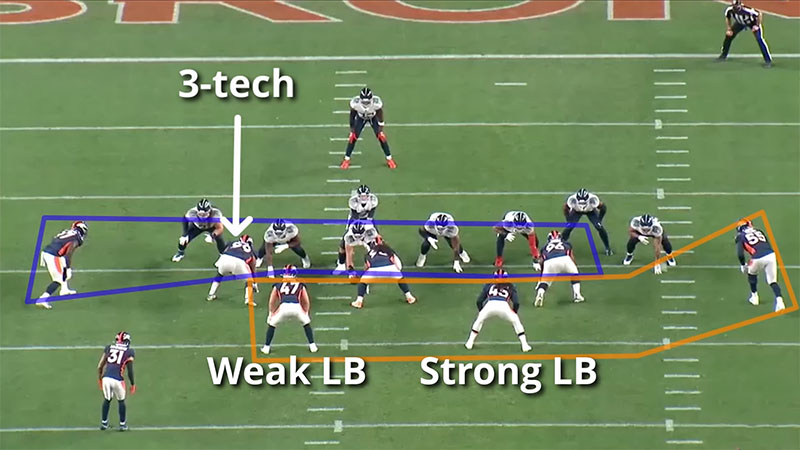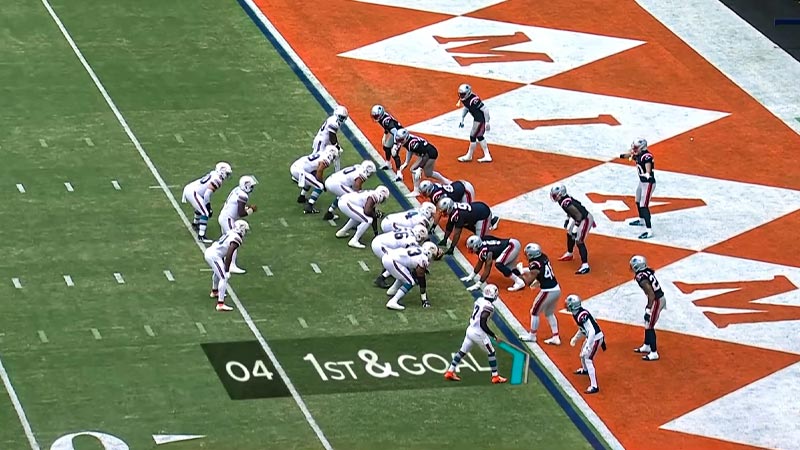Diving into the intricate world of football, defensive formations emerge as the strategic backbone, shaping the resilience of a team against diverse offensive threats.
From the classic 4-3 defense to the dynamic nickel and dime packages, each formation is a tactical masterpiece designed to counter specific challenges on the field.
This blog post unfolds the playbook, presenting a comprehensive list of football defensive formations. Delve into the intricacies of the 3-4’s versatility, the prevent defense’s late-game prowess, and the nimble 2-4-5’s adaptability.
As we explore each formation, we’ll uncover the strategic nuances that coaches employ to optimize their team’s defensive capabilities, creating a symphony of skill, adaptability, and game-time intelligence.
What Is Football Defensive Formations?
Football defensive formations are strategic alignments of players teams employ to counteract the opposing offense.
These formations dictate the arrangement of the field’s defensive linemen, linebackers, and defensive backs.
The choice of formation depends on the opponent’s strengths, offensive tendencies, and game situation. Examples include the 4-3, 3-4, or nickel formations.
Formations can prioritize stopping the run, defending against the pass, or striking a balance. They provide coaches with flexibility, allowing them to optimize personnel, create mismatches, and adapt to evolving offensive trends.
Defensive formations play a crucial role in game management, influencing down-and-distance decisions, red zone defense, and late-game situations, reflecting the dynamic chess match in football.
Football Defensive Formations list

There are a lot of defensive formations in American football. Here are the 20 most important defensive formations:
4-3 Defense

The 4-3 defense is a classic formation with four defensive linemen and three linebackers. It offers a balanced approach, providing solid run defense and pass-rushing capabilities.
The four linemen aim to pressure the quarterback, while the three linebackers offer versatility in covering both the run and pass.
This formation maintains control at the line of scrimmage, making it a popular choice for teams seeking a well-rounded defensive strategy.
3-4 Defense
The 3-4 defense features three defensive linemen and four linebackers, emphasizing flexibility and adaptability.
This formation is known for its ability to disguise blitzes and create confusion for opposing offenses. The three linemen focus on occupying blockers, allowing linebackers to make plays.
The 3-4 is particularly effective against both the run and pass, making it a favorite among teams seeking a dynamic defensive scheme.
4-4 Defense
The 4-4 defense deploys four defensive linemen and four linebackers, creating a robust front eight to control the line of scrimmage.
This formation is a power-oriented approach, excelling in stopping the run and providing strong containment against outside plays.
With eight defenders close to the line, the 4-4 defense is effective in short-yardage and goal-line situations, relying on strength and disciplined gap control.
5-2 Defense
The 5-2 defense employs five defensive linemen and two linebackers, creating a sturdy front to disrupt opposing offenses.
This formation is designed to control the line of scrimmage, limiting running lanes and putting pressure on the quarterback.
The five linemen aim to dominate the trenches while the two linebackers provide additional support.
The 5-2 is often utilized by teams looking to establish a physical presence on the defensive front, making it challenging for opponents to establish a consistent rushing attack.
6-1 Defense
The 6-1 defense is characterized by six defensive linemen and a single linebacker, focusing on stopping the run and pressuring the quarterback.
The six linemen aim to overwhelm the offensive line, creating havoc in the backfield. The lone linebacker is responsible for pursuing ball carriers and providing coverage support.
This formation is particularly effective against teams with a strong running game, as it concentrates defensive strength in the front six while maintaining a presence in pass coverage with the linebacker.
The 6-1 is a specialized formation often employed in specific game situations.
4-2-5 Defense
The 4-2-5 Defense is a popular and versatile formation in American football. It features four defensive linemen, two linebackers, and five defensive backs.
This formation is effective against both the run and pass, providing a balanced approach.
The four linemen offer a strong front, while the two linebackers provide support against the run. With five defensive backs, including three safeties, the 4-2-5 is well-equipped to defend against the pass.
It is a flexible formation, allowing teams to adjust easily to various offensive strategies, making it a go-to choice for many coaches seeking adaptability and solid all-around defense.
3-3-5 Defense
The 3-3-5 Defense is characterized by three defensive linemen, three linebackers, and five defensive backs. This formation is known for its flexibility and ability to adapt to different offensive schemes.
The three linemen provide a sturdy front, while the three linebackers offer support against both the run and pass.
With five defensive backs, including three safeties, the 3-3-5 defends against the pass, making it particularly effective in today’s pass-heavy game.
This formation’s strength lies in its adaptability, allowing teams to easily transition between different defensive strategies based on the opponent’s offensive approach.
3-2-6 Defense
The 3-2-6 Defense is a specialized formation designed primarily to defend against the pass. With three defensive linemen, two linebackers, and six defensive backs, it maximizes coverage in the secondary.
The three linemen aim to generate pressure on the quarterback, while the additional defensive backs provide extensive coverage against the pass.
This formation is often utilized when opponents are likely to rely heavily on passing plays, such as during two-minute drills or in third-and-long situations.
The 3-2-6 Defense prioritizes speed and coverage skills, aiming to disrupt passing lanes and limit the effectiveness of aerial attacks.
4-1-6 Defense
The 4-1-6 Defense is an aggressive, pass-focused formation featuring four linemen, one linebacker, and six defensive backs.
This formation is commonly employed when teams expect a high volume of passing plays. The four linemen aim to pressure the quarterback, while the lone linebacker provides additional support against the run.
The strength of the 4-1-6 lies in its secondary coverage, with six defensive backs offering a wide range of coverage skills.
This formation is often utilized in obvious passing situations, providing defenses with the speed and coverage necessary to effectively disrupt and defend against aerial attacks.
Nickel Defense
The Nickel Defense is a widely used formation, typically employed on passing downs when the defense expects the opposing team to throw the ball.
It involves replacing one of the traditional linebackers with a fifth defensive back, known as the Nickelback.
This extra defensive back enhances coverage against multiple receivers, effectively countering passing plays.
Dime Defense
Like the Nickel Defense, the Dime Defense takes it further by substituting two linebackers with two additional defensive backs.
This formation aims to maximize pass coverage, especially when the offense will likely air out the ball.
With six defensive backs, the Dime Defense provides added flexibility against various passing schemes.
Quarter Defense
The Quarter Defense is an extreme adaptation to defend against the pass. It features seven defensive backs, replacing all but one of the traditional front seven players.
This formation is rare and is primarily employed in desperate situations, such as preventing a last-minute touchdown.
The focus is on preventing deep passes and securing the end zone, sacrificing run defense in the process.
46 Defense
The 46 Defense, popularized by legendary coach Buddy Ryan, is a unique and aggressive formation. It deploys four down linemen, six linebackers, and a single safety playing deep.
The formation is designed for intense pressure on the quarterback, emphasizing disrupting the backfield and overwhelming offensive lines.
It gained fame with the 1985 Chicago Bears, showcasing its effectiveness in creating chaos and limiting offensive options.
Bear Defense
The Bear Defense is a variation of the 46 Defense, emphasizing a strong defensive line.
It typically features a nose tackle over the center and two defensive tackles over the guards, creating a “bear hug” on the offensive line.
The idea is to control the line of scrimmage and stifle the run game by dominating in the trenches.
While originally associated with the 46 Defense, the Bear Defense has evolved into a standalone strategy, showcasing its effectiveness in shutting down opposing rushing attacks.
Prevent Defense
The Prevent Defense is employed when a team protects a lead in late-game situations.
It typically involves dropping several defensive players deep to prevent long passes, sacrificing pressure on the quarterback for increased coverage.
The objective is to minimize the risk of a quick, game-changing score by the opposing team. While effective in preventing deep throws, it can leave gaps underneath, allowing for shorter gains.
Teams must balance the Prevent Defense’s conservative nature with the need to tackle and defend the intermediate passing game.
Goal Line Defense
Goal Line Defense is a formation designed to stop the opposing team from scoring when they are close to the end zone.
It often features a heavy concentration of defensive linemen and linebackers, aiming to plug gaps and prevent rushing touchdowns.
Cornerbacks may play tight coverage to minimize passing options in this condensed field. The goal is to create a formidable wall at the goal line, relying on strength and quick reactions to thwart short-yardage attempts.
This formation prioritizes stopping the run and forces offenses to execute precise plays in tight quarters.
3-3-5 Eagle Defense
The 3-3-5 Eagle Defense is a modern and versatile formation known for its flexibility.
It consists of three down linemen, three linebackers, and five defensive backs. This formation combines the strength of a traditional front with the agility of additional defensive backs, allowing for effective pass coverage.
The three linemen aim to create pressure, while the linebacker corps is responsible for both run support and coverage.
The 3-3-5 Eagle Defense is particularly effective against spread offenses, as it provides a balance between stopping the run and defending against the pass.
3-1-7 Defense
The 3-1-7 Defense is an extreme variation, emphasizing pass coverage by deploying three linemen, one linebacker, and seven defensive backs.
This formation is deployed when the opposing team is expected to pass frequently, such as in “Hail Mary” scenarios or against highly prolific passing offenses.
With many defensive backs, this formation aims to smother receivers and limit deep threats.
The lone linebacker often has dual responsibilities, providing some run support while primarily focusing on coverage assignments.
The 3-1-7 Defense is a high-risk, high-reward strategy designed for specific game situations.
3-2-5 Defense
The 3-2-5 Defense is a flexible formation with three down linemen, two linebackers, and five defensive backs.
It combines elements of both traditional and nickel defenses, offering solid run defense with increased coverage capabilities.
The three linemen work to disrupt the offensive line while the two linebackers provide support against the run and pass.
The five defensive backs offer versatility in coverage schemes, making them effective against various offensive strategies.
The 3-2-5 Defense is often used to counterbalance offenses, adapting to both the run and pass without sacrificing too much in either aspect.
2-4-5 Defense
The 2-4-5 Defense features two down linemen, four linebackers, and five defensive backs, creating a balanced formation suitable for defending against both the run and pass.
This formation prioritizes speed and agility, with the four linebackers providing flexibility in both pass coverage and support.
The two linemen focus on disrupting the offensive line, while the five defensive backs offer coverage options.
The 2-4-5 Defense is effective against spread offenses and passing-heavy strategies, providing a strong front against the run while maintaining the ability to cover various receiving threats.
Importance of the Football Defensive Formations

Football defensive formations are crucial for a team’s success as they dictate how it defends against the opposing offense.
The importance of these formations lies in their ability to adapt to various offensive strategies and situations.
Here are key aspects highlighting their significance:
Strategic Flexibility
Defensive formations allow teams to adapt their strategies based on the opponent’s strengths and weaknesses.
Coaches can choose formations that best counter the opposing team’s offensive style, whether it’s a strong running game, a potent passing attack, or a balanced approach.
Stopping the Run or Pass
Different formations excel at defending against specific aspects of the game.
For example, formations like the 4-3 or 3-4 are better suited for stopping the run, while nickel or dime formations are designed to defend against the pass.
Adjusting formations based on the situation is crucial for defensive success.
Personnel Utilization
Formations help coaches make optimal use of their defensive personnel. If a team has strong defensive linemen, they might opt for formations that emphasize a formidable front.
Alternatively, formations with additional defensive backs may be preferred to enhance pass coverage if the secondary is a strength.
Down and Distance Considerations
Defensive formations also take into account the down and distance situations.
For instance, goal-line formations are employed when the offense is close to scoring, while prevent defenses are used in preventable passing situations.
Adaptation to Trends
Football is dynamic, and offensive trends evolve. Defensive formations must adapt to new offensive strategies, such as spreading offenses or increasing emphasis on passing.
Staying ahead of these trends is crucial for a defense’s effectiveness.
Creating Mismatches
Coaches use defensive formations to create mismatches against the opposing offense.
For example, employing nickel or dime formations against multiple-receiver sets aims to match defensive backs’ speed and coverage skills against receivers.
Game Situation Management
Defensive formations are vital for managing game situations.
Prevent defenses are deployed in late-game scenarios when protecting a lead, while aggressive formations like the blitz-heavy 3-4 defense may be used when a team needs to force a turnover or a quick stop.
Red Zone Defense
Different formations are often used in the red zone to prevent opponents from scoring touchdowns. This requires balancing preventing runs and defending against passes in a confined space.
Psychological Impact
The mere presence of different defensive formations can psychologically impact the opposing offense.
Unpredictability and adaptability make it challenging for offenses to anticipate defensive strategies, leading to uncertainty and potential mistakes.
Defensive formations are a strategic tool that coaches use to optimize their team’s defensive capabilities.
Their importance lies in their ability to adapt, counter, and control the game in response to the ever-changing dynamics of football.
FAQs
What is a football defensive formation?
A football defensive formation is the strategic arrangement of players on the defensive side of the ball.
It determines the positions of linemen, linebackers, and defensive backs, aiming to counteract the opposing offense based on the situation and the opponent’s strengths.
What is the purpose of defensive formations in football?
Defensive formations serve to optimize a team’s defense by adapting to the opponent’s style. They allow coaches to tailor strategies, emphasizing strengths and minimizing weaknesses.
The formations address specific threats, whether it’s stopping the run, defending against the pass, or managing game situations.
How do defensive formations impact game strategy?
Defensive formations influence game strategy by offering flexibility. Coaches choose formations based on the opponent’s tendencies, adapting to different offensive styles.
This adaptability allows defenses to create mismatches, control the pace, and respond effectively to the evolving dynamics of a football game.
Can defensive formations change during a game?
Yes, defensive formations can change during a game. Coaches may adjust formations based on the opponent’s in-game adjustments, emerging trends, or specific situations.
This flexibility allows teams to respond dynamically to offensive strategies and optimize their defense throughout the course of a match.
What are some common football defensive formations?
Common football defensive formations include the 4-3, 3-4, nickel, dime, and goal-line defenses. Each has a unique alignment of linemen, linebackers, and defensive backs, serving different strategic purposes.
Teams select formations based on the opponent’s offensive strengths, down-and-distance situations, and overall game strategy.
Wrapping Up
In the dynamic landscape of football, defensive formations stand as the unsung architects of victory. This exploration of formations, from the robust 4-3 to the nuanced nickel, underscores the chess match within the game.
Coaches strategically deploy these formations, adapting to opponents, optimizing personnel, and steering the course of a match.
As we conclude this journey through the defensive playbook, we recognize that beyond the Xs and Os, the strategic brilliance within these formations elevates the game, turning each play into a tactical symphony on the gridiron.
The defensive formations, like the players who execute them, are the unsung heroes defining the narrative of football contests.







